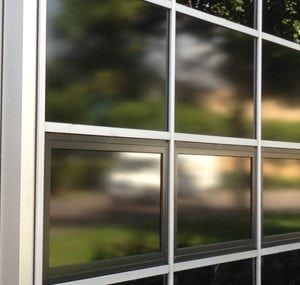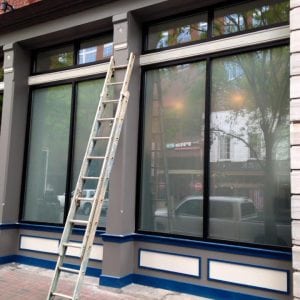Common Types of Architectural Window Film
November 24, 2021Why Window Tint
November 30, 2021Window films have numerous benefits for home and building owners. Window films are made of PET or Polyethylene Terephthalate. You apply them to glass windows in commercial buildings or homes.
The films have a scratch-resistant outer surface coating that protects the film, giving it longevity.
Window films come in many types. Some are transparent and have several PET layers to make them shatter-proof. Others are pigment, metal, or dye tinted to minimize the light transmitted and block the sun’s heat. You can also have decorative films that have etched patterns or a frosted glass appearance.
Types of Architectural Window Films
The market is flooded with many types of window films. Some of the most common include:
Reflective
The reflective film reflects light on the outside and is sometimes called a one-way mirror film. Reflective window film prevents anyone from seeing through your windows, but you can see outside.
Dual Reflective
This film’s exterior is quite reflective and mirrors the surrounding images. On the inside, it is not as reflective, but you can still see outside.

Spectrally Selective
This film selects how much light will enter a room, simultaneously blocking out excess heat.
A spectrally selective window film allows 89% daylight and 45% solar heat. The spectrally selective film should be transparent but still able to reduce glare and heat.
Decorative
Decorative films enhance your windows and make them look more pleasing to the eye.
Neutral
Neutral window films provide 99% UV protection and reduce glare.
Ceramic
This film is transparent and allows good visibility day and night. The film is more durable and contains ceramic nanoparticles.
Low E (Emissivity)
This film blocks or slows UV ray transmission. Low-E films reflect 70 to 80% of the sun’s heat on hot days and conserve at least 50% of a building’s heat on cold days.
 Benefits of Window Films for Architects
Benefits of Window Films for Architects
Architects bring practical and functional fruition to their clients’ visions. They balance what their client wants with industry recommendations and their expertise. The architect has to consider the functionality of the finished product, who will use it, and the resources needed to bring that idea to life.
In an architectural blueprint, the glass used on the building is a significant part of the architectural process. You have numerous options, but implementing window films can play a substantial role in privacy and other benefits, including:
1. Energy Conservation
Using window films in buildings is essential for privacy and aesthetics and crucial for energy conservation. When you use window films, your building designs are also well insulated to keep the heat inside during winter.
The buildings also keep cooler during summer as the films block the sun’s heat. The film also means that in winter, you conserve energy by heating the building less. In summer, your clients use the air conditioning systems less, thus saving energy and reducing energy bills.
2. Fewer Damages
As mentioned, some window films have numerous layers of PET. These layers enhance safety in your building because they make glass shatter-proof. If someone breaks the window in a break-in, the film ensures the glass does not shatter. The film holds the shards together and makes it harder for the intruder to break the glass completely.
In natural disasters, the PET holds the glass together, protecting anyone inside the building from the glass shards that might cause significant physical harm. Besides physical window strength, the window film also protects the glass from unsightly scratches. It also protects from small cracks that become bigger with time and break the glass.
3. More Privacy
Everybody desires privacy. If your building faces another building or a busy street, you will want to keep people from seeing into the building. Window films provide this privacy, and there are different films you can use for this, such as:
- Reflective
- Dual reflective
- Spectrally selective
Depending on the type of window film, you will get varying degrees of privacy as per your needs. Clear windows mean anyone can spy on you and give burglars better knowledge of what is in your office or home. A film that allows you to look outside but prevents people from looking inside is the best for privacy.
4. Consistent Comfort
Window films offer you consistent comfort. In summer, when buildings get hot, a building fitted with window films is comfortably cool. Comfort is vital besides energy-saving, especially in an office building where employees must be comfortable for maximum productivity.
According to a survey by CareerBuilder of 4285 workers, work temperatures were crucial to productivity. 22% said their workplaces were too hot, making it hard to concentrate, and 11% said similar about cold workplaces.
When it’s cold, the inside of a building fitted with window films will always be comfortably warm. The comfort’s consistency is because the window films do not break down or need maintenance like ACs. Window films also reduce glare, allowing you to use your computer and watch TV more comfortably.
5. Affordability
While fitting window films is an investment, it is an affordable option. Windows break, and without window film, your windows are at higher risk of breaking. You reduce the likelihood of glass cracking from pebbles and debris with window films, especially if you live in a windy area.
Window films become an affordable investment compared to changing cracked window glasses all the time, which costs more in the long run. When you compare the cost of buying frosted glass and film, you are much better off buying window films as they are more affordable.
6. UV Protection
Typical windows with no film let in up to 50% of solar radiation. Ultraviolet or UV rays from the sun are as harmful to furniture and furnishings as human skin. The same way we apply sunscreen to protect our skin is the same way we need to fit window films to protect our property.
Over time, the sun’s radiation damages flooring, furniture, and other furnishings like carpets by fading them. Architectural window films reduce this damage to furniture and furnishings by blocking at least 99% UV rays.
The blockage of UV rays depends on the type of film and the tint you choose, and your geographical location. A window film fitted in a building in Texas is not the same one you fit in a cooler place like South Dakota.
7. Aesthetics
Architectural window films come in various colors and light densities, ranging from reflective colors that go with your home’s décor to transparent. Decorative window films allow you to inject some color into your windows.
Decorative films allow you to experiment with creative designs such as frosted or etched glass patterns. These patterns transform your home or business with elegance and do not make your windows look too cluttered.
8. Brand Creativity
Standard windows often look bland in a business building. When you add a decorative window film, you attract people’s attention. As an architect, you can suggest that your client have custom-made films with their business name and logo.
Such window films are an excellent way to advertise their business, and it catches the attention of people from afar. The custom-made film allows you to be as creative as possible. The beauty of this option is that you can permanently remove it any time you want to change the branding.
Conclusion
Architectural window films are an excellent way to enhance the look of your windows and have myriad benefits. As the architect, you have the onus of bringing your clients’ dreams and visions to life, but within reason. Using your expertise, you have to advise your client on the type of glass and window film to use for maximum ROI.
Different films have different characteristics, and before you advise the client, know their reasons for the film, if privacy or merely for decoration. This way, you can advise on the best type to use.
